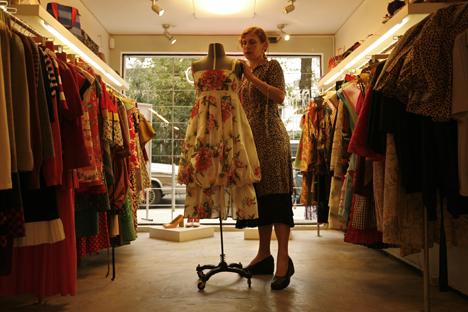Mexican designers fuse tradition with modern style to appeal mass market

The Associated Press
Oct 25, 2006
Last updated on May 12, 2016 at 05:44 a.m.
MEXICO CITY – From a distance, the black woolen jacket created by fashion designer Carla Fernandez looks like a simple, ordinary blazer. The difference is in the details: bright, multicolored dots embroidered to a piece that combines age-old Indian sewing techniques with an innovative, modern cut.
Fernandez, one of six designers at the Local clothing boutique in Mexico City’s trendy Condesa neighborhood, works with women in the southern Mexican states of Chiapas and Oaxaca to create a product that is local in its use of indigenous design, but also made for a modern woman who wants something stylish.
“What I wanted to do was to use their methods to do something that was very sexy and very appealing to this market,” she said.
Fernandez is just one example of several young talents in Mexico City looking to make it onto the international fashion stage by offering modern designs with a clear Mexican flavor. The new crop of designers hopes to take advantage of Mexico’s increasingly stabilized economy, which has improved over the last six years during Vicente Fox’s presidency. Designers say their new businesses are finding receptive customers, both local and foreign.
Get The Daily Illini in your inbox!
“The next step has to be Mexico, in a way,” Ferandez said, noting that Colombia, Brazil and Argentina have already attracted a fair amount of attention.
The designs are found primarily in small boutiques for now, with department stores continuing to stock European or American clothing. But events such as Mexico’s growing Fashion Week are giving them a boost. About 30 designers, mostly Mexican, participated in the April show and at least 40 designers are expected when the four-day event begins again Oct. 24, said Anna Fusoni, the event’s fashion director.
Fusoni looks for participants who have both a Mexican cultural element and the ability to sell to a mass market, such as Pineda Covalin and Carmen Rion, she said.
“They have to have a focus. They have to have a market,” she said. “It’s global design with a local touch.”
For Fernandez, who is not participating in Fashion Week, local means blending age-old sewing techniques with modern style.
Fernandez started to form her style while working at a Mexico City Indian culture museum that is now closed. There she noticed the prominence of squares and rectangles in the Mesoamerican clothing.
“I thought it could be a great thing to try to explore this concept of making clothing and making fashion,” she said.
Fernandez says she chose to use rectangles because rather than cutting fabrics, Indian people tear them along the line of the weave, making curves in garments using pleats and darts in the fabric. She took a gently ruffled skirt off the rack and showed how if its stitches were removed, the fabric would relax back into rectangles.
To help make her clothing, Fernandez works with non-governmental organizations in Chiapas and Oaxaca to organize groups of women in sewing groups that double as public health education seminars. The women work with the designer to develop ideas for each piece, she said. They are paid per item, and can also benefit by preserving traditional techniques while making clothes for their own children.
“They are very happy because it’s like making a new story every day,” Fernandez said.
Her typical customers are artists, actresses, and others who “dare to dress differently,” she said. But they’re also people who can afford it – that little black jacket is priced at about $240 and the pleated skirt at about $120.
In Polanco, another hip and wealthy, if more conservative, part of town, designer Adriana Hans says she is also seeing more interest in Mexican fashion, both from local women and international buyers.
“I feel that Mexico is in a transition,” said Hans, who makes custom-decorated tank tops as co-owner of the small but trendy line, Wishes. “There is a really strong change.”





